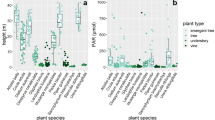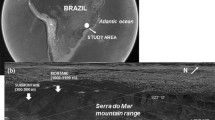Abstract
Orchidaceae is the largest family of plants, reaching its maximum diversity in Colombia where 4000 species have been registered. One particular ecosystem with high diversity of orchids is the tropical montane cloud forest characterized by high humidity and low air temperatures. However, due to anthropic pressure such as land use change its area has been reduced. This is not the only anthropic disturbance that can affect the continuity of this forest and orchids, climate change and nitrogen deposition also become threats. By means of elemental composition and isotopic measurements of carbon and nitrogen, we determined the photosynthetic pathway for orchids from a tropical cloud forest in Colombia, for which, we also evaluated the nutritional status of nitrogen and its relationship with atmospheric deposition. We found 46 species from 18 genera; of these, 19 species were epiphytic, 9 lithophytic and 18 terrestrials. The carbon content was not significantly different among the species evaluated, averaging 46.4 ± 0.41% (dry weight). In turn, only one terrestrial orchid had a nitrogen content above 2.2%, averaged 1.4 ± 0.07% for the remaining 45 species. The δ13C that averaged − 28.1 ± 0.4‰ for 45 species was typical of C3 plants, while only one species, whose δ13C of 18.8‰ can be considered CAM. The δ15N values for 44 orchids were negative, in total they ranged from − 8.1 to 4.5‰. It can be concluded that the temperatures in this area are not yet high enough to produce a noticeable change in photosynthesis as evidenced by the carbon content of orchids, however, the expected rise would bring harmful consequences for these populations of orchids, especially when considering that these orchids were collected at the highest altitudinal range of the region. Moreover, the rates of nitrogen deposition are not high enough yet to leave a significant signal in the vegetation.


Similar content being viewed by others
References
Andrade J, de la Barrera E, Reyes-García C, Ricalde M, Vargas-Soto G, Cervera J (2007) El metabolismo ácido de las crasuláceas: diversidad, fisiología ambiental y productividad. Bol Soc Bot Mex 81:37–50. https://doi.org/10.17129/botsci.1764
Armenteras D, Cadena C, Moreno RP (2007) Evaluación del estado de los bosques de niebla y de la meta 2010 en Colombia. Instituto de Investigación de Recursos Biológicos Alexander Von Humbolt. Bogotá, D.C.
Bruijnzeel LA (2001) Hydrology of tropical montane cloud forests: a reassessment. Land Use Water Res 1:1.1–1.18
Bush MB, Silman MR, Urrego DH (2004) 48,000 years of climate and forest change in a biodiversity hot spot. Science 303:827–829. https://doi.org/10.1126/science.1090795
Cernusak LA, Tcherkez G, Keitel C, Cornwell WK, Santiago LS, Knohl A, Barbour MM, Williams DG, Reich PB, Ellsworth DS, Dawson TE, Griffiths HG, Farquhar GD, Wright IJ (2009) Why are non-photosynthetic tissues generally13C enriched compared with leaves in C3 plants? Review and synthesis of current hypotheses. Funct Plant Biol 36:199–213. https://doi.org/10.1071/FP08216
Colwell RK, Brehm G, Cardelús CL, Gilman AC, Longino JT (2008) Global warming, elevational range shifts, and lowland biotic attrition in the wet tropics. Science 322:258–261. https://doi.org/10.1126/science.1162547
Cushman JC (2001) Crassulacean acid metabolism. A plastic photosynthetic adaptation to arid environments. Plant Physiol 127:1439–1448
Decina SM, Templer PH, Hutyra LR, Gately CK, Rao P (2017) Variability, drivers, and effects of atmospheric nitrogen inputs across an urban area: emerging patterns among human activities, the atmosphere, and soils. Sci Total Environ 609:1524–1534 (Doi: 10.1016/j.scitotenv.2017.07.166)
Díaz-Álvarez E, de la Barrera E (2018) Characterization of nitrogen deposition in a megalopolis by means of atmospheric biomonitors. Sci Rep 8:13569. https://doi.org/10.1038/s41598-018-32000-5
Díaz-Álvarez E, Lindig-Cisneros R, de la Barrera E (2015) Responses to simulated nitrogen deposition by the neotropical epiphytic orchid. Peer J 3:e1021. https://doi.org/10.7717/peerj.1021
Díaz-Álvarez E, Reyes-García C, de la Barrera E (2016) A δ15N assessment of nitrogen deposition for the endangered epiphytic orchid Laelia speciosa from a city and an oak forest in Mexico. J Plant Res 129:863–872. https://doi.org/10.1007/s10265-016-0843-y
Díaz-Álvarez E, Lindig-Cisneros R, de la Barrera E (2018) Biomonitors of atmospheric nitrogen deposition: potential uses and limitations. Conserv Physiol. https://doi.org/10.1093/conphys/coy011
Doumengue C, Gilmour D, Ruíz-Pérez M, Blockhus J (1995) Tropical montane cloud forests: conservation status and management issues. In: Hamilton LS, Juvik JO, Scatena FN (eds) Tropical montane cloud forests. Ecological studies. Springer Verlag, New York, pp 24–37
Ehleringer JR, Osmond BO (1989) Stable isotopes. In: Pearcy RW, Ehleringer J, Mooney HA, Rundel PW (eds) Plant physiological ecology. Chapman & Hall, London, pp 281–300
Evans RD, Bloom AJ, Sukrapanna SS, Ehleringer JR (1996) Nitrogen isotope composition of tomato (Lycopersicon esculentum Mill. cv. T-5) grown under ammonium or nitrate nutrition. Plant, Cell Environ 19:1317–1323. https://doi.org/10.1111/j.1365-3040.1996.tb00010.x
Felix JD, Elliott ME, Shaw SL (2012) Nitrogen isotopic composition of coal-fired power plant NOx: influence of emission controls and implications for global emission inventories. Environ Sci Technol 46:3528–3535. https://doi.org/10.1021/es203355v
Felix JD, Elliot EM, Gish TJ, Maghirang R, Cambal L, Clougherty J (2014) Examining the transport of ammonia emissions across landscapes using nitrogen isotope ratios. Atmos Environ 95:563–570
Felix JD, Elliot EM, Gay DA (2017) Spatial and temporal patterns of nitrogen isotopic composition of ammonia at US ammonia monitoring network sites. Atmos Environ 150:434–442
Galloway JN, Detener FJ, Capone DG, Boyer EW, Howarth RW, Seitzinger SP, Asner GP, Cleveland CC, Green PA, Holland EA, Karl DM, Michaels AF, Porter JH, Townsend AR, Vöosmarty CJ (2004) Nitrogen cycles: past, present, and future. Biogeochemistry 70:153–226. https://doi.org/10.1007/BF03187108
Galloway JN, Townsend AR, Erisman JW, Bekunda M, Cai Z, Freney JR, Martinelli LA, Seitzinger SP, Sutton MA (2008) Transformation of the nitrogen cycle: recent trends, questions, and potential solutions. Science 320:889–892. https://doi.org/10.1126/science.1136674
Giraldo G, Betancur J (2011). Guía de campo de las orquídeas de Santa María (Boyacá, Colombia). Serie guías de campo del Instituto de Ciencias Naturales, Universidad Nacional de Colombia No. 9. Instituto de Ciencias Naturales, Universidad Nacional de Colombia, Bogotá
Goudi AS (2019) Human impact on the natural environment, Eight edn. Wiley, New Jersey
Hamilton LS (1995) Mountain cloud forest conservation and research: a synopsis. Mt Res Dev 15:259–266. https://doi.org/10.2307/3673933
Hamilton SD, Hopmans P, Chalk PM, Smith CJ (1993) Field estimation of N2 fixation by Acacia spp. using 15N isotope dilution and labelling with 35S. Forest Ecol Manag 56:297–313. https://doi.org/10.1016/0378-1127(93)90119-8
Hietz P, Wanek W, Popp M (1999) Stable isotopic composition of carbon and nitrogen and nitrogen content in vascular epiphytes along an altitudinal transect. Plant, Cell Environ 22:1435–1443. https://doi.org/10.1046/j.1365-3040.1999.00502.x
Hoch G, Roemer H, Fioroni T, Olmedo I, Kahmen A (2017) First experimental evidence for carbon starvation at warm temperatures in epiphytic orchids of tropical cloud forests. Geophysical Research Abstracts, vol 19, EGU2017-2920
IDEAM (2018) Promedios climatológicos 1981–2010. http://www.ideam.gov.co/web/tiempo-y-clima/clima. Accessed 20 Aug 2018
IPCC (2014) Climate Change 2014: synthesis report. In: Pachauri RK, Meyer LA (eds) Contribution of working groups I, II and III to the Fifth Assessment Report of the Intergovernmental Panel on Climate Change. IPCC, Geneva
Ma S, Feng H, Tian D, Zou D, Yan Z, Yang Y, Zhou T, Huang K, Shen H, Fang J (2018) Variations and determinants of carbon content in plants: a global synthesis. Biogeosciences 15:693–702. https://doi.org/10.5194/bg-15-693-2018
Mardegan SF, Nardoto GB, Higuchi N, Reinert F, Martinelli LA (2011) Variation in nitrogen use strategies and photosynthetic pathways among vascular epiphytes in the Brazilian Central Amazon. Rev bras bot 34:21–30
Mooney HA (1972) The carbon balance of plants. Ann Rev Ecol Syst 3:315–346
Ometto JPHB, Ehleringer JR, Domingues TF, Berry JA, Ishida FY, Mazzi E, Higuchi N, Flanagan LB, Nardoto GB, Martinelli LA (2006) The stable carbon and nitrogen isotopic composition of vegetation in tropical forests of the Amazon Basin, Brazil. In: Martinelli LA, Howarth RW (eds) Nitrogen cycling in the Americas: natural and anthropogenic influences and controls. Springer, Dordrecht, pp 251–274
Ordóñez-Blanco J, Parrado-Rosselli A (2017) Relación Fenología-Clima De Cuatro Especies De Orquídeas En Un Bosque Altoandino De Colombia. Lankesteriana 17:1–15. https://doi.org/10.15517/lank.v17i1.27897
Osmond CB, Allaway WG, Sutton BG, Troughton JH, Queiroz O, Lüttge U, Winter K (1973) Carbon isotope discrimination in photosynthesis of CAM plants. Nature 246:41–42
Pierce S, Winter K, Griffiths H (2002) Carbon isotope ratio and the extent of daily CAM use by Bromeliaceae. New Phytol 156:75–83. https://doi.org/10.1046/j.1469-8137.2002.00489.x
Reina-Rodríguez GA, Rubiano JE, Castro FA, Otero JT (2016) Spatial distribution of dry forest orchids in the Cauca River Valley and Dagua Canyon: towards a conservation strategy to climate change. J Nat Conserv 30:32–43. https://doi.org/10.1016/j.jnc.2016.01.004
Reyes-García C, Griffiths H (2009) Ecophysiological studies of perennials of the Bromeliaceae family in a dry forest: strategies for survival. In: de la Barrera E, Smith WK (eds) Perspectives in biophysical plant ecophysiology, a tribute to Park S. Nobel. Universidad Nacional Autónoma de México, Ciudad de México, pp 121–151
Sala OE, Chapin SF III, Armesto JJ, Berlow E, Bloomfield J, Dirzo R, Huber-Sanwald E, Huenneke LF, Jackson RB, Kinzig A, Leemans R, Lodge DM, Mooney HA, Oesterheld M, Poff NL, Sykes MT, Walker BH, Walker M, Wal DH (2000) Global biodiversity scenarios for the year 2100. Science 287:1770–1774. https://doi.org/10.1126/science.287.5459.1770
Scholl M, Eugster W, Burkard R (2011) Understanding the role of fog in forest hydrology: stable isotopes as tools for determining input and partitioning of cloud water in montane forests. Hydrol Process 25:353–366. https://doi.org/10.1002/hyp.7762
Silvera K, Lasso E (2016) Ecophysiology and crassulacean acid metabolism of tropical epiphytes. In: Goldstein G, Santiago L (eds) Tropical tree physiology. Tree physiology, vol 6. Springer, Cham. pp 25–43
Silvera K, Santiago LS, Winter K (2005) Distribution of crassulacean acid metabolism in orchids of Panama: evidence of selection for weak and strong modes. Funct Plant Biol 32:397–407. https://doi.org/10.1071/FP04179
Silvera K, Santiago LS, Cushman JC, Winter K (2009) Crassulacean acid metabolism and epiphytism linked to adaptive radiations in the Orchidaceae. Plant Physiol 149:1838–1847. https://doi.org/10.1104/pp.108.132555
Silvera K, Santiago LS, Cushman JC, Winter K (2010) The incidence of crassulacean acid metabolism in Orchidaceae derived from carbon isotope ratios: a checklist of the flora of Panama and Costa Rica. Bot J Linn Soc 163:194–222. https://doi.org/10.1111/j.1095-8339.2010.01058.x
Zech M, Bimüller C, Hemp A, Samimi C, Broesike C, Hörold C, Zech W (2011) Human and climate impact on 15N natural abundance of plants and soils in high-mountain ecosystems: a short review and two examples from the Eastern Pamirs and Mt. Kilimanjaro. Isotopes Environ Health Stud 47:286–296. https://doi.org/10.1080/10256016.2011.596277
Zhang S, Yang Y, Li J, Qin J, Zhang W, Huang W, Hu H (2018) Physiological diversity of orchids. Plant Divers 40:196e208. https://doi.org/10.1016/j.pld.2018.06.003
Zotz G, Winkler U (2013) Aerial roots of epiphytic orchids: the velamen radicum and its role in water and nutrient uptake. Oecologia 171:733–741. https://doi.org/10.1007/s00442-012-2575-6
Acknowledgements
We thank Dr. P. Rose for allowing the use of analytical balance, Mr. A. Díaz for sending samples from Colombia, Mrs. G. Álvarez and Ms. V. Díaz whose help was important during the fieldwork, and the personnel of the Universidad INCCA de Colombia for providing access to the convection oven. The authors also want to thank Rev. P. Ortiz and Prof. J. Betancour for help with the identification of some orchids, as well as Ms. C. Torres and Ms. A.P. Rojas who participated in previous expeditions to the study region when searching for the different orchids. EADA thanks generous Beca Mixta CONACYT and PAEP-UNAM grants which funded a research visit to Texas A&M Corpus Christi, EADA also thanks Posgrado en Ciencias Biológicas, UNAM for financial support for field work.
Author information
Authors and Affiliations
Corresponding author
Additional information
Communicated by U. Feller.
Publisher's Note
Springer Nature remains neutral with regard to jurisdictional claims in published maps and institutional affiliations.
Rights and permissions
About this article
Cite this article
Díaz-Álvarez, E.A., Felix, J.D. & de la Barrera, E. Elemental and isotopic assessment for Colombian orchids from a montane cloud forest: a baseline for global environmental change. Acta Physiol Plant 41, 99 (2019). https://doi.org/10.1007/s11738-019-2893-y
Received:
Revised:
Accepted:
Published:
DOI: https://doi.org/10.1007/s11738-019-2893-y




